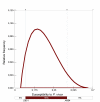A quantitative risk assessment approach for mosquito-borne diseases: malaria re-emergence in southern France
- PMID: 18673551
- PMCID: PMC2527012
- DOI: 10.1186/1475-2875-7-147
A quantitative risk assessment approach for mosquito-borne diseases: malaria re-emergence in southern France
Abstract
Background: The Camargue region is a former malaria endemic area, where potential Anopheles vectors are still abundant. Considering the importation of Plasmodium due to the high number of imported malaria cases in France, the aim of this article was to make some predictions regarding the risk of malaria re-emergence in the Camargue.
Methods: Receptivity (vectorial capacity) and infectivity (vector susceptibility) were inferred using an innovative probabilistic approach and considering both Plasmodium falciparum and Plasmodium vivax. Each parameter of receptivity (human biting rate, anthropophily, length of trophogonic cycle, survival rate, length of sporogonic cycle) and infectivity were estimated based on field survey, bibliographic data and expert knowledge and fitted with probability distributions taking into account the variability and the uncertainty of the estimation. Spatial and temporal variations of the parameters were determined using environmental factors derived from satellite imagery, meteorological data and entomological field data. The entomological risk (receptivity/infectivity) was calculated using 10,000 different randomly selected sets of values extracted from the probability distributions. The result was mapped in the Camargue area. Finally, vulnerability (number of malaria imported cases) was inferred using data collected in regional hospitals.
Results: The entomological risk presented large spatial, temporal and Plasmodium species-dependent variations. The sensitivity analysis showed that susceptibility, survival rate and human biting rate were the three most influential parameters for entomological risk. Assessment of vulnerability showed that among the imported cases in the region, only very few were imported in at-risk areas.
Conclusion: The current risk of malaria re-emergence seems negligible due to the very low number of imported Plasmodium. This model demonstrated its efficiency for mosquito-borne diseases risk assessment.
Figures















Similar articles
-
Malaria risk in Corsica, former hot spot of malaria in France.Malar J. 2010 Aug 12;9:231. doi: 10.1186/1475-2875-9-231. Malar J. 2010. PMID: 20704707 Free PMC article.
-
Survivorship of Anopheles darlingi (Diptera: Culicidae) in relation with malaria incidence in the Brazilian Amazon.PLoS One. 2011;6(8):e22388. doi: 10.1371/journal.pone.0022388. Epub 2011 Aug 8. PLoS One. 2011. PMID: 21857927 Free PMC article.
-
[Current malaria situation in the Republic of Kazakhstan].Med Parazitol (Mosk). 2001 Jan-Mar;(1):24-33. Med Parazitol (Mosk). 2001. PMID: 11548308 Russian.
-
A case of autochthonous Plasmodium vivax malaria, Corsica, August 2006.Travel Med Infect Dis. 2008 Jan-Mar;6(1-2):36-40. doi: 10.1016/j.tmaid.2007.09.042. Epub 2007 Nov 5. Travel Med Infect Dis. 2008. PMID: 18342272 Review.
-
Malaria entomological profile in Tanzania from 1950 to 2010: a review of mosquito distribution, vectorial capacity and insecticide resistance.Tanzan J Health Res. 2011 Dec;13(5 Suppl 1):319-31. Tanzan J Health Res. 2011. PMID: 26591987 Review.
Cited by
-
A framework for assessing local transmission risk of imported malaria cases.Infect Dis Poverty. 2019 Jun 7;8(1):43. doi: 10.1186/s40249-019-0552-6. Infect Dis Poverty. 2019. PMID: 31174612 Free PMC article.
-
The global distribution and transmission limits of lymphatic filariasis: past and present.Parasit Vectors. 2014 Oct 11;7:466. doi: 10.1186/s13071-014-0466-x. Parasit Vectors. 2014. PMID: 25303991 Free PMC article.
-
Importance of wetlands management for West Nile Virus circulation risk, Camargue, Southern France.Int J Environ Res Public Health. 2014 Aug 4;11(8):7740-54. doi: 10.3390/ijerph110807740. Int J Environ Res Public Health. 2014. PMID: 25093652 Free PMC article.
-
Geostatistical modeling of malaria endemicity using serological indicators of exposure collected through school surveys.Am J Trop Med Hyg. 2015 Jul;93(1):168-177. doi: 10.4269/ajtmh.14-0620. Epub 2015 May 11. Am J Trop Med Hyg. 2015. PMID: 25962770 Free PMC article.
-
Airport Malaria in Non-Endemic Areas: New Insights into Mosquito Vectors, Case Management and Major Challenges.Microorganisms. 2021 Oct 16;9(10):2160. doi: 10.3390/microorganisms9102160. Microorganisms. 2021. PMID: 34683481 Free PMC article. Review.
References
-
- Rodhain F, Charmot G. Evaluation des risques de reprise de transmission du paludisme en France. Med Mal Infect. 1982;12:231–236.
-
- Sautet J. A propos d'une épidémie de paludisme en Camargue. Mars Med. 1944;2:53–64.
-
- Ponçon N, Toty C, L'Ambert G, Le Goff G, Brengues C, Schaffner F, Fontenille D. Population dynamics of pest mosquitoes and potential malaria and West Nile virus vectors in relation to climatic factors and human activities in the Camargue, France. Med Vet Entomol. 2007;21:350–357. - PubMed
MeSH terms
LinkOut - more resources
Full Text Sources
Medical

